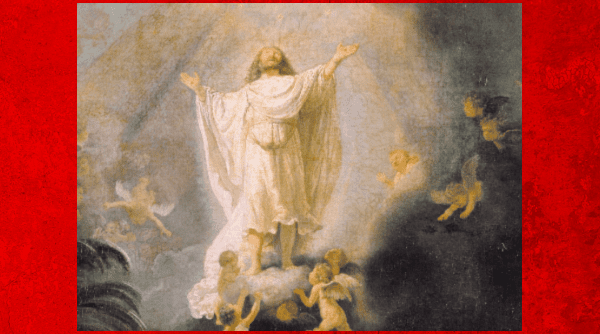St. Thomas the Apostle was absent when the Risen One visited the other Apostles in the upper room on the evening of Easter Sunday. Informed of the Lord’s visit, St. Thomas refused to believe the Apostles’ testimony until he could see for himself and touch the very wounds of Christ. St. John records what happened after this refusal: “Eight days later, his disciples were again in the house, and Thomas was with them. The doors were shut, but Jesus came and stood among them, and said, ‘Peace be with you.’ Then he said to Thomas, ‘Put your finger here, and see my hands; and put out your hand, and place it in my side; do not be faithless, but believing.’ Thomas answered him, ‘My Lord and my God!’ Jesus said to him, ‘Have you believed because you have seen me? Blessed are those who have not seen and yet believe’” (John 20:26-29).
From this exchange, it seems clear that St. Thomas was only willing to confess the Risen One to be his Lord and God after he had seen Him in the flesh and, moreover, after he had touched Him. For St. Thomas wanted to have for himself the certitude proper to the sense of touch. Commenting on this encounter between St. Thomas and Christ, Charles De Koninck observes: “The attitude of St. Thomas the Apostle is not an example to be imitated, yet in it we recognize a familiar experience: whenever we wish to be very certain about the reality of a thing, of the existence of a sensible object, we want to verify by touch. And it is especially for this reason that touch is called the sense of certitude, while sight is the sense of distinction, of clarity, and of representation.” That St. Thomas’s attitude “is not an example to be imitated” is clear enough from how our Lord reproaches him: “Have you believed because you have seen me? Blessed are those who have not seen and yet believe.” Still, as De Koninck notes, given our natural human mode of knowing, and our natural way of attaining certitude about the reality of things in this world, St. Thomas’s desire to employ “the sense of certitude” as a kind of help is not surprising. And, mercifully, our Lord condescends to St. Thomas’s human weakness and causes him to bring forth an act of divine faith.
Interestingly, this incident with St. Thomas is the second report which St. John relates of someone touching the Risen One. The first report involves St. Mary Magdalene during her visit to the empty tomb. As soon as St. Mary recognizes the Risen One and lovingly lays hold of Him, our Lord responds, “Do not touch me, for I have not yet ascended to the Father; but go to my brethren and say to them, I am ascending to my Father and your Father, to my God and your God” (John 20:17). The divine response given here may well puzzle us, especially since it seems to stand in such stark contrast to the way our Lord responds to St. Thomas’s desire to touch Him.
This puzzlement dissolves, however, as soon as we carefully consider the reason Christ gives to St. Mary Magdalene, namely, “for I have not yet ascended to the Father.” In giving this reason, our Lord teaches St. Mary both that she is not to touch Him physically before His Ascension, and that she is to touch Him in some other way after His Ascension. Through this twofold teaching, Christ is preparing St. Mary Magdalene and, by extension, all of His followers for how they are to touch Him when, seated at the right hand of the Father in Heaven, He is no longer sensibly present to them. More precisely, says St. Augustine, they and we are to touch the Risen One spiritually or as the object of the act of the theological virtue of faith formed by charity.
By teaching us to touch Him spiritually through supernatural acts of faith, our Lord reveals to us a mode of union with Him which is at once higher and more certain than the physical mode of union achievable through the sense of touch. In other words, when we lay hold of the Risen One through a supernatural act of faith, we are united to Him intellectually, as opposed to physically, and the firmness of this union is properly divine, as opposed to merely human.
So, by considering the reports of St. Thomas and St. Mary Magdalene touching the Risen One, we observe two different modes of union with Christ and we see that our Lord desires us to be united with Him according to the higher and more certain of these modes. That being said, in our spiritual lives our Lord continues to condescend in a merciful manner to our human weakness. For as Fr. Gabriel of St. Mary Magdalene explains: “Jesus had pity on the tottering faith of the Apostle, and on ours, too; and He allowed him not him not only to see Him, as He had allowed the others, but also to touch Him, thereby permitting Thomas, the incredulous, to do what He had not permitted Mary Magdalen, the most faithful one. From this incident we derive a better understanding of God’s ways. Whereas He gives sensible consolations and more or less palpable signs of His presence to souls who are still wavering in the faith, He often leads by very obscure paths those who have irrevocably given themselves to Him and on whose faith He can count. God is a Father. He never denies to any soul who seeks Him with sincerity the necessary props to support its faith, but He often refuses to the strong what He grants to the weak.” During this Paschaltide, let us beg the Risen One to increase in us the theological virtue of faith so that our spiritual union with Him may become ever purer and more profound.
Editor’s note: Would you like to work towards a certification in Spiritual Theology? Dr. Arias will be teaching an introductory class this summer. We invite you to explore that here–along with many other offerings in our Graduate Program.
image credit:Rembrandt / Public domain




